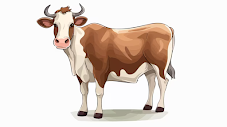The Cow Economy
Man, feeds cow! Cow feeds man!Few
months back, I visited Gujarat on a 10-day long trip, to explore the state.
While there were so many interesting places to see there, something that uncommonly
caught my attention was the cattle on the roads. I could see a lot of cows on
the roads and as such I also noticed there was no over-speeding on the highway
as the local drivers, where concerned about the safety, of both the passengers
and the frequently trespassing cattle.
It
was fascinating to see the way, how cows and people, happily co-exist there.
Rather than happy, I should say how they profitably co-exist as they see mutual
benefits, in this co-existence. This is why I have given the title for this
article “The Cow Economy”. Let me explain it further.
In
Gujarat cows are not killed, for meat. There is no cow slaughtering, however
leather from the dead cow is sold.
When
there is so much of economic benefit, from a cow, why would they slaughter it.
It reminds me of the story we probably learnt at school about “The Goose that lays golden eggs”, which I
think suits the cow too.
So,
not just dairy products, but all the products that man gets from cow, helps him
to generate revenue, which makes it
lucrative for people to breed cows. In olden days, it was a practice in many
households all over India, to have a cow in the house, for the many things that
household members can get from it. Even today we find it in a few houses and
many farm lands, because it leads to a win – win situation.
In addition to economic benefits, cows also have a spiritual significance to the Hindus. Cows are considered a divine animal in the Hindu religion. Most of the Hindu's don't consume beef, for the same reason. Cow is believed to be a home to all the Gods. It is likened to Goddess Mahalakshmi, for the prosperity it brings, which is evident through the methods of revenue, I have already stated.
When we walk around the temples in Gujarat, we can see roadside vendors selling flour balls, as an offering to be given to the cows. Many pilgrims buy it and feed the cow, as a way of religious act. We can also see people touching the cow and placing it in their eyes, as a sign of respect.
To
put it in simple words, we can say, “Man feeds cow and in turn the cow feeds
man” which is a win – win strategy for both the human and the cow.
While
the dirt and mess created by the cows in public, can be annoying, it opened my
perception to why this co-existence continues to be in practice, even after so
many years of civilization. I could understand that the relationship of the
Gujaratis with the cow, is not just logical, but also an emotional.
D. Senthil Kannan,
%20Ltd..png)




%20Ltd.-1.png)


%20Ltd..png)
No comments:
Post a Comment